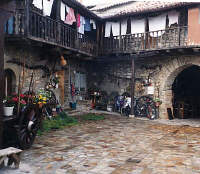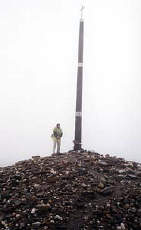
Orbigo Bridge: The Orbigo Bridge is the longest bridge of the entire Camino.
![]()
“Con pan y vino se anda el camino.”
(“The path is walked with bread and wine.”)
When was the last time the only thing written on your to-do list was “walk” – for 12 days straight? There’s something absolutely liberating about this one simple activity, and there’s one place in Spain where there’s an 800km route perfectly mapped out to do just that. The route is called the Camino de Santiago (Path of Saint James) and thousands of people from all over the world partake in the experience every year, starting from anywhere along the path and ending in the enchanting city of Santiago de Compostela in the northwest corner of Spain.
The route follows the path taken by ancient pilgrims making their way to the city of St. James as a sort of religious rite. Today, modern pilgrims can follow the same route and partake in a similar experience as those who walked the path more than a thousand years ago. Although the pilgrimage today is complete with albergues (dorm-style hostels designed especially for pilgrims), it continues to keep the ancient feel of hospitality and camaraderie as people unite to achieve one common goal: to arrive in Santiago.
The most common and ancient Camino route begins on the French-Spanish border in the Pyrenees mountain range and continues across northern Spain, through Pamplona, Burgos and León heading towards the Atlantic. The original religious Camino connected Rome and Santiago, two of the most important Christian cities in the world. The best thing about the Camino, however, is that there are as many routes as there are pilgrims, and there’s really no wrong way to accomplish the feat.
When my friend Beth and I decided to take the Camino challenge we were disappointed that we couldn’t tackle all 800km, but our two-week time span just wouldn’t allow for the distance. Instead, we started our version of the Camino in Leon, about 310km outside of Santiago.
Days 1-3: Leon to Rabanal del Camino
The first day of our Camino, we got a slow start as we had to go through the Camino credential process to become official Camino de Santiago pilgrims with official Camino passports. It seemed like a silly and tedious formality, but this would allow us to keep track of the towns we passed through and stay for next to nothing in the pilgrim’s albergues. Afterward, we just started walking. Really nothing much else to it, except stopping once for directions out of Leon. Before we knew it we were outside of the city following the conch shell signs (the symbol of St. James and therefore the Camino). We were the only pilgrims on the path and weren’t too impressed yet with the scenery as we wound our way around the side of the highway. But, it was our first day, and the excitement of our first crunching steps were perfectly accompanied by the occasional horn honked encouragingly from cars whizzing by.
Reaching our first albergue, we threw together some dinner while chatting with a chipper Italian man who gave us tips on walking. Apparently he had been having trouble with tendonitis, and I began to worry a bit as I watched other pilgrims hobble around the albergue with braces here and Band-Aids there.
It was still daylight when I threw myself down onto the mattress placed on the floor, and shut my eyes in pure exhaustion.
The next day we began our early-to-bed, early-to-rise routine. We were happy to see that this day we weren’t alone on the Camino, but unfortunately the route continued along the highway. First thing in the morning a petite speedy lady from Cordoba stormed by us with her drying underwear flapping behind her. Later in the day we ran across a Spanish writer who was taking down names and anecdotes for a book he planned to write about the Camino. We greeted everyone we came across with an “hola” and saw them off wishing them a “buen camino” no matter what language they spoke.
As the fatigue started to set in later in the day we passed through a tiny pueblo and over the Orbigo Bridge, one of the longest bridges of the entire Camino. One of the locals we greeted, mumbled to us “poco a poco” as we trudged past with our packs. With only 30 km under our belt and a couple of hundred left to go, we really had no other choice but to go little by little.
But each “poco” that we accomplished brought a new face, a new view, and a new pain that we had never known before.
Our second night, in Astorga, we bunked next to a blind woman from Canada who had been walking since the Pyrenees, doing only about seven kilometers a day. Amazing. Just making her way around the maze of bunk beds in the albergue seemed like enough of a chore. Another night we became acquainted with a 60-something Spanish couple who kept everyone in the room awake, telling us stories and cracking jokes about their tired and aching muscles and their monstrous blisters.
At the end of the third day, my own feet already had a beautiful pair of blisters that ended up being a thorn in my side for the next month. The cringing look of simultaneous disgust and sympathy that flashed on people’s faces as they glanced at the raw flesh on my heels is still burnt in my memory.

Albergue: This albergue (hostal), located in Rabanal del Camino is the only one in town.
![]()
Days 4-6: Rabanal del Camino to O’Cebreiro
The next three days of the walk brought the two most beautiful and simultaneously difficult ascensions of our Camino. The first one, up to the Cruz de Ferro (the Iron Cross), goes over a mountain pass deserted of albergues, except for a small emergency shack in the two-man town of Manjarín. (The two men being one who serves hot coffee from inside the junk-filled building, and another who hangs around outside to ring a bell announcing the arrival of each pilgrim.)
Arriving to the Cruz de Ferro is one of the most important symbolic rites of the entire Camino. The pilgrim tradition is to bring a small rock from your homeland to leave at the foot of the cross and ensure your arrival in Santiago. Today, the pile of rocks is so large that pilgrims have to climb a winding path on the hill of rocks to leave their offering at the foot of the cross.
It snowed the day Beth and I climbed up to the cross. It was the first and only snow we saw during the entire walk, but it was followed by several days of guaranteed rain, typical of May in Northern Spain.
Despite the weather, the kilometers started to whiz by faster and faster each day. We weren’t necessarily walking any faster, but were paying less attention to walking itself. We were now away from the highway and in the rolling hills, passing through fertile vineyards and abandoned towns with crumbling buildings. We started our days early and ended the day when the silliness of exhaustion had taken full effect. Before we knew it we had finished the first 100 km and were crossing the border into the province of Galicia after climbing the second ascension. We stopped in O’Cebreiro, our first Galician town, perched on the mountaintop and gave our tired feet a rest.

Cruz de Ferro: It’s pilgrim tradition to place a rock from your homeland on this pile of stones at the Cruz de Ferro.
![]()
Days 7-9: O’Cebreiro to Eirexe
That night in O’Cebreiro, the first six days of accomplishment caught up with my body and sleep was nearly impossible. Still not feeling my best the next morning, it was slow going getting ready, and when we stepped outside into a brewing storm, I knew we weren’t going to make the 34 km we had planned for the day.
The rain poured down; a thick and looming fog covered the beautiful Galician countryside; my feet throbbed and head pounded. It was the only day of the entire Camino when all I was able to think about was the journey’s end. Our rainy mood was only elevated for a few moments, when an old woman dressed in mismatched clothes thrown all about her popped out of her kitchen with a hot plate of sugary crepes to ease the pains. She only told us after we had finished eating that the sweet snack would cost us “un euro.”
By the end of the seventh day we had only gone 20 km, and the entire schedule I had unofficially planned in my head was all out of order. For several days we had been falling just a bit short of our minimum goal for one reason or another, and this day had set us back even more.
Lying in the albergue bunk bed trying to recuperate that afternoon, I couldn’t help but think about all those kilometers we had lost because of my feeling under the weather. Then, I thought of the blind lady I had met only a few days earlier who was completely content to walk 7km a day. We weren’t really getting off schedule, because there was no need for one at all. The only consequence of making schedules so far had been not being able to keep them.
The next morning I felt a hundred percent better, and Beth and I ended up making up for some of those “lost” kilometers without even thinking about it. It was one of the first beautiful sunny days we had seen for a while, so I threw on my sandals to give my feet a break from the heavy boots. I only discovered later the stupidity of this choice, as I slipped and slid on the muddy cattle paths weaving through the green Galician farmland. It wasn’t the dirt that bothered me, necessarily, as I had pretty much forgotten what clean felt like, but rather the fact that Beth might have the golden opportunity to photograph me face down in the mushy mud and I’d be unable to get up for the weight of my pack. It remained a looming threat for the rest of the rainy days.
Questions?
If you want more information about this area you can email the author or check out our Europe Insiders page.